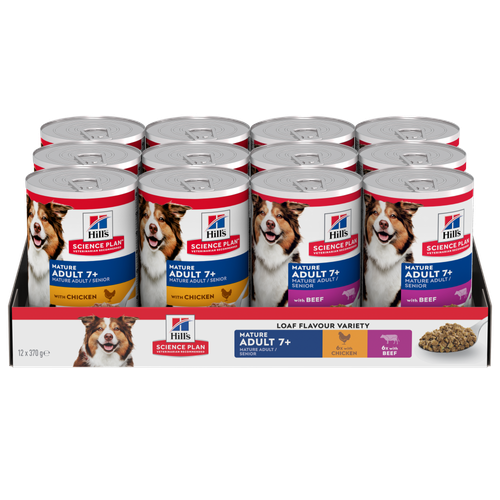
-
Find the right food for your petTake this quiz to see which food may be the best for your furry friend.Find the right food for your petTake this quiz to see which food may be the best for your furry friend.Featured products
 Mature Adult Dog Food
Mature Adult Dog FoodHill's Science Plan Mature Adult Multipack Wet Dog Food with Chicken & Beef are complete premium pet foods for mature adult dogs from 7 years. Your dog will love these deliciously smooth and savoury minced loaves, formulated to deliver the appropriate amount of energy to support the needs of adult dogs.
Shop Now Puppy Food
Puppy FoodHill's Science Plan Puppy Multipack Wet Dog Food with Chicken & Beef are complete premium pet foods for growing puppies from weaning until 1 year old and for pregnant and nursing dogs. Your puppy will love these deliciously smooth and savoury minced loaves, formulated for balanced nutrition and overall health.
Shop Now Adult Wet Dog Food with Beef
Adult Wet Dog Food with BeefHill's Science Plan Adult Multipack Wet Dog Food with Chicken, Beef & Turkey are complete premium pet foods for adult dogs from 1 year. Your dog will love these deliciously smooth and savoury minced loaves, formulated for balanced nutrition and overall health.
Shop NowFeatured products Adult Multipack Wet Cat Food with Beef, Ocean Fish & Chicken
Adult Multipack Wet Cat Food with Beef, Ocean Fish & ChickenTender chunks in gravy for cats, with high-quality protein to maintain lean muscle. With vitamin E and omega-3s & -6s for healthy skin and balanced minerals to support healthy vital organs.
Shop Now Mature Adult Wet Cat Food with Chicken
Mature Adult Wet Cat Food with Chicken
Tender chicken chunks in gravy for mature adult cats. Made with easy-to-digest ingredients, high-quality protein for lean muscle maintenance and antioxidant vitamins C+E for optimal health.
Shop Now Light Adult Multipack Wet Cat Food with Chicken & Ocean Fish
Light Adult Multipack Wet Cat Food with Chicken & Ocean FishTender chicken chunks in gravy for cats, with L-carnitine and fewer calories for ideal weight management. Packed with high-quality protein, omega-6s, and vitamin E for shiny fur and healthy skin.
Shop Now -
Dog
- Dog Tips & Articles
-
Health Category
- Weight
- Food & Environmental Sensitivities
- Urinary
- Digestive
- Joint
- Kidney
-
Life Stage
- Puppy Nutrition
- Adult Nutrition
- Senior Nutrition
Cat- Cat Tips & Articles
-
Health Category
- Weight
- Skin & Food Sensitivities
- Urinary
- Digestive
- Kidney
-
Life Stage
- Kitten Nutrition
- Adult Nutrition
Featured articles Show some love with wet foods: a great choice for pets with health issues
Show some love with wet foods: a great choice for pets with health issuesShow some love with wet foods: a great choice for pets with health issues.
Read More The Right Diet For Your Pet
The Right Diet For Your PetIn people, the right diet is very important. If you are eating the wrong way for your metabolism, activity level, age and lifestyle you could end up with health issues.
Read More The Incredible Science Behind Your Pet's Microbiome
The Incredible Science Behind Your Pet's MicrobiomeLearn what your pet's microbiome is, how it contributes to your pet's gut and overall health, and why nutrition is important in maintaining healthy microbiomes.
Read More -


How big will my puppy get? This is one of the most frequent questions veterinarians get from new puppy parents or experienced dog lovers who have adopted a new-to-them breed. Some ask out of pure curiosity, others want to know so they can ensure they have enough space in their home before adopting. They also wonder about other logistical concerns, such as what size crate, dog bed or collar they should buy before bringing home their new furry friend.
While your vet will be the best person to guide you through puppy growth and expected size, there are some other well-known suggestions, such as looking at paw size or breed markers that may (or may not) guide you in the right direction. Here are some of the most common ways to estimate how big your dog will be.
Does Paw Size Prove Anything?
Some like to say that the bigger a dog's paws are as a puppy, the larger they’ll be when grown up. However, it's not always a good judge of what to expect. A hefty Bernese mountain dog will have bigger paws to hold them up than a corgi, but there are larger dogs with small paws for their size (like a dainty collie) and vice versa (like a bulldog). Just like any human kid, your puppy may have tall, thin, tubby, or disproportionate phases as they grow.


Tasty Tips
Purebred Versus Mixed Breed
Wondering "how big will my puppy get?" after adopting a lovable dog? Well, unfortunately, you may have to wait until fully grown to be sure. If you don't know your pup's precise mix, how genes will influence their size is a guessing game. If you know that your dog is a mix of two small breeds or two large breeds, you may be able to guess how large they’ll be when fully grown, but remember, it's still an estimate.
The final size of a purebred pup is still surprisingly hard to predict. They could be the smallest or largest pup of the litter, or grow at a different rate than other dogs of the same breed due to an illness as a puppy. Reading up on the standards of an official breed club can help you judge how big dogs of that breed are.
Your veterinarian should be able to give you guidelines for what you can expect from your pet's growth. If you're someone who likes to research for yourself, check out The Kennel Club’s dog breed database for the expected size range of each breed.
Check out the Parents
One of the best ways to determine an approximate expected height and weight for your dog would be to take a look at the mum and dad, if possible. Their grown height and weight will likely be a good determinant of what to expect from your own dog. In fact, this is often suggested for humans, as well. However, many adopters won't know much, if anything at all, about their new pet's parents.
Chart the Growth
Another method, that's a little more tedious, is to chart your dog's growth over time. Many dogs will become fully grown by one year old, but some breeds may take an extra six months to a year. Charting your dog's growth from puppy to three months old, to six months old, to one year will help you get a better sense of how big they’ll be once fully grown. However, this method requires you to estimate based on what other pet parents of similar breeds have experienced. Your dog is unique, and individual traits are the biggest determining factor for the overall size.
There's no science for determining how big your pup will be, except for looking at breed history and consulting a vet. It's best to do your research early, so you can spend the time with your new pet playing and enjoying each other's company. And when in doubt, buy the bigger crate.


Erin Ollila believes in the power of words and how a message can inform—and even transform—its intended audience. Her writing can be found all over the internet and in print, and includes interviews, ghostwriting, blog posts, and creative nonfiction. Erin is a geek for SEO and all things social media. She graduated from Fairfield University with an M.F.A. in Creative Writing. Reach out to her on Twitter @ReinventingErin or learn more about her at http://erinollila.com.
Related products

Hill's Science Plan Adult Multipack Wet Dog Food with Chicken, Beef & Turkey are complete premium pet foods for adult dogs from 1 year. Your dog will love these deliciously smooth and savoury minced loaves, formulated for balanced nutrition and overall health.

Hill's Science Plan Hypoallergenic Adult Wet Dog Food with Salmon is a complete premium pet food for all adult dogs from 1 year. This savoury tinned loaf is specially formulated for dogs with delicate skin and stomachs. It features a single novel animal protein source and is grain-free.

Hill's Science Plan Mature Adult Multipack Wet Dog Food with Chicken & Beef are complete premium pet foods for mature adult dogs from 7 years. Your dog will love these deliciously smooth and savoury minced loaves, formulated to deliver the appropriate amount of energy to support the needs of adult dogs.

Hill's Science Plan Puppy Multipack Wet Dog Food with Chicken & Beef are complete premium pet foods for growing puppies from weaning until 1 year old and for pregnant and nursing dogs. Your puppy will love these deliciously smooth and savoury minced loaves, formulated for balanced nutrition and overall health.
Related articles

Learn about the potential health risks of a raw diet for dogs and why they aren't the best option for your pup or you.

Learn effective tips for feeding a dog that's a picky eater and ensure proper nutrition for a finicky eater. Discover tips for pet parents at Hill's Pet UK.

Many human foods are dangerous to dogs. Read about 5 of the worst toxic food offenders that can kill your dog - and how much it takes to hurt them.

How, when and what to feed your new puppy is an important decision, learn more about the things to consider for feeding your puppy.

Put your dog on a diet without them knowing
Our low calorie formula helps you control your dog's weight. It's packed with high-quality protein for building lean muscles, and made with purposeful ingredients for a flavourful, nutritious meal. Clinically proven antioxidants, Vitamin C+E, help promote a healthy immune system.
Put your dog on a diet without them knowing
Our low calorie formula helps you control your dog's weight. It's packed with high-quality protein for building lean muscles, and made with purposeful ingredients for a flavourful, nutritious meal. Clinically proven antioxidants, Vitamin C+E, help promote a healthy immune system.


